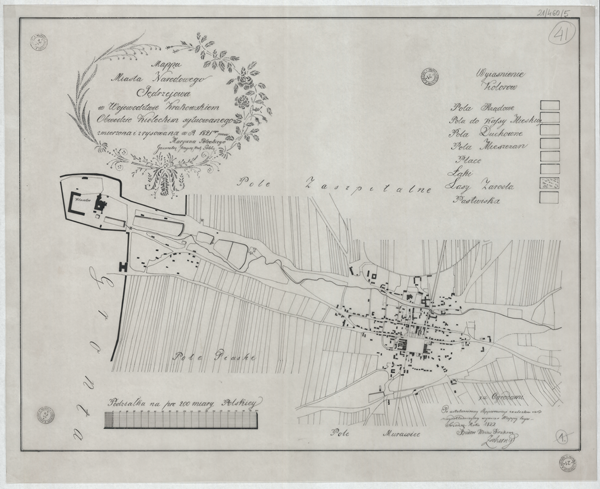primary studying of relationship among coronal mass ejections, bs events and geomagnetic storms liu siqing1 gong jiancun1 j.k. chao2 xue bin
PRIMARY STUDYING OF RELATIONSHIP AMONG CORONAL MASS EJECTIONS, Bs
EVENTS AND GEOMAGNETIC STORMS
Liu Siqing1 Gong Jiancun1 J.K. Chao2 Xue Bingshen1
1 Center for Space Science and Applied Research, CAS,
P.O. Box 8701, Beijing 100080, China Fax: 86-10-62542551, email:
[email protected]
2 Institute of Space Sciences, National Central University, Chong-li,
Taiwan, China
Abstract. Two interesting solar events that took place in July 14,
2000 and Sept. 12, 2000 were studied in this paper. Two brilliant
full-halo coronal mass ejections (CME) were recorded by the
Coronagraphs on SOHO during these two events. The first CME accompany
with a X5.7 x-ray flare which is one of the most powerful solar flares
in the current solar cycle. A filament disappearance and a powerful
x-ray solar flare were observed in the second event. However, the
effects of these two solar events are quite different from each other.
An extreme geomagnetic storm was triggered by the first CME, but the
second one just led geomagnetic disturbances. It is well known that
long duration of large southward interplanetary magnetic field (Bs
event) is the primary cause of geomagnetic storms. Comparing these two
events, we find that the IMF structures of the associated CME events
are different. It is shown that the central axial field direction in
magnetic cloud (MC) is related to magnetic field structure of the
source region on the disc. Therefore we can predict the possibility of
Bs events through the magnetic structure on the photosphere, because
of the variation of IMF Bz can be deduced by MC Model.
1. Introduction
With the arrival of the maximum of 23rd solar cycle, more and more
extreme solar events are observed. Since intense geomagnetic storms
triggered by these events can cause disruption of satellite operation,
communications, navigation, and electric power distribution grids,
leading to a variety of socioeconomic losses, they become the key
factor of space environment forecast (space weather). It is well known
that solar eruption events, such as flares, coronal mass ejection
(CME), filament disappearance, and eruptive prominences, are able to
cause geomagnetic disturbance and geomagnetic storms. But it doesn’t
mean that each solar event can cause an intense geomagnetic storm. The
key problem of geomagnetic storm forecast is the characters of solar
eruptions which can trigger intense geomagnetic storm.
A large number of observations and studies indicate that: the primary
cause of geomagnetic storms are the long-duration southward
interplanetary magnetic fields (IMF) in GSM coordinate system, so-called
Bs events, which play an important role in determining the amount of
solar wind energy to be transferred to the magnetosphere (Arnoldy,
1971; Tsurutani and Meng, 1972; Russell and McPherron, 1981; Akasofu,
1981; Gonzalez and Tsurutani, 1987) . When the sun erupts, it can
suddenly and violently release bubbles or tongues of gas, and magnetic
fields called coronal mass ejections (CMEs). Bs events usually occur
within the interplanetary material associated with a CME, but not
every CME will cause Bs event. It may be related to the characters of
CME. To find what kind of CME will cause Bs event is the key goal of
predicting geomagnetic storm associated with CME.
Scientists have been trying to forecast IMF Bz component according to
the configuration of the photospheric magnetic field on solar source
for many years. In 1976, Pudovkin and Chertkov claimed that the
strength of geomagnetic disturbances could be predicted by the
north-south disturbances of the photospheric magnetic field at the
site of a solar flare (Pudovkin et al, 1976). In order to study the
relationship between solar magnetic field and the variations of IMF
Bz, at 1AU, Tang et al (Tang et al. 1985, 1989) examined the
relationship between the polarity of the transient variation of IMF Bz
and the associated flare field. Recently, Zhao et al (Zhao and
Hoeksema, 1998) found that magnetic cloud central axial field
directions were correlated with the central axial field directions of
the associated filament on the Sun.
In this paper, two interesting events which took place in 2000 are
analyzed. The relationships among the solar source magnetic field
structure on photosphere, the transient variation of IMF Bz and the
strength of the related geomagnetic disturbance are studied. It is
confirmed that the interior magnetic structure of MC is close related
to the photospheric magnetic field of the solar eruption source on the
Sun. This result may be helpful in forecasting IMF Bs event and
geomagnetic disturbance using magnetic field data on the solar
surface.
2. Solar events of July 14, 2000 and Sept. 12 2000
At 1003UT on July 14, 2000 (Event A) , one of the most powerful solar
flares of current solar cycle was recorded by NOAA satellites and the
orbiting Solar and Heliospheric Observatory (SOHO). Its x-ray flux in
1.0-8.0 Angstrom band measurement onboard GOES-8 satellite reached
5.34×10-4watt/m2. Energetic proton arrived at the Earth about 15
minutes after the eruption. About 20 minutes after the breakup of the
solar flare, coronagraphs (LASCO C2 and LASCO C3) on board SOHO
recorded a bright “full-halo” CME. Solar material appeared to be
heading toward our planet with a speed of 1300 to 1800 km/s. The
interplanetary shock wave related to the CME hit the Earth at 1418UT,
July 15. Meanwhile an extreme geomagnetic storm took place.
Geomagnetic field index Kp equals 9 for 9 hours.
Solar Event
July 14, 2000(Event A)
Sept. 12, 2000(Event B)
Flare class
X5.7/SF
M1.0/2N
CME
Full-Halo CME
Filament Disappearance, Full-halo CME
Position
N16E02
S12W18
Proton Event
Yes
Yes
Radio Storm
II IV
II
Shock Wave
Yes
Yes
Bs Event
Bz<-10 for 7 hours
None
Geomagnetic Storm
Extreme Geomagnetic Storm(Kp=9)
None
Table1:Comparison of these two solar events and their terrestrial
effects
The other event was produced on Sept. 12 (Event B). A filament
collapsed, spawning a powerful x-ray solar flare and a brilliant
full-halo CME. The shock wave hit the Earth at about 0400UT on Sept.
15, however it didn’t cause a geomagnetic storm.
(a) (b)
Fig. 1. A filament disappearance recorded at the Big Bear Solar
Observatory through a red Hydrogen-alpha filter
Comparing these two solar events (table 1), some similarities can be
found. (1) Both of them have some important solar eruptive phenomena,
such as flare, CME, Type II radio storm; (2) The eruption positions
are near the center of the disc, and the CMEs aimed at the Earth; (3)
Interplanetary shock waves were observed; (4) Proton events were
observed in both events. The differences between these two events are:
(1) The intensity of these two events are different: the eruption in
Event A is stronger than Event B; (2) In Event A, the related IMF has
a southward component (Bz< -10nT) for at least 7 hours, whereas in
Event B, the IMF is northward; (3) Extreme geomagnetic storm was
triggered in Event A. The Kp index equals 9 for about 9 hours; Dst
index reached –295. On the contrary, no geomagnetic storm took place
during Event B.
3. the Relationship between the Structure on the Photosphere and IMF
Structure
From the above analysis, it is found that the most important reason of
the different geomagnetic effects of these two events should be the
intensity of the eruption and configuration of IMF within the solar
material. The intense southward IMF Bz is associated with two types of
origins (Gonzalez and Tsurutani, 1987). One of them has an intrinsic
solar origin. The other type has an interplanetary origin.
(a) (b)
Fig. 2. The magnetogram observed as the solar erupted
In the event of first type,
the southward IMF Bs event is just a part of the internal magnetic
field in the ejected plasmas from the sun. At this case, the magnetic
structure in the flare regions must have some characteristic features.
Fig. 2 is the solar magnetogram of these two events. In these
pictures, blue and green indicate the magnetic field is outwards, red
and yellow indicate the magnetic field is inwards. The brightness
represents the intensity of the magnetic field. A big difference can
be found in these two pictures: The eruption in Event A comes from an
unusual north-south oriented active region. The magnetic neutral line
in the source area is parallel with the equatorial plane (Fig. 2a).
The eruption in Event B comes from a usual east-west oriented active
region with the magnetic neutral line perpendicular to the equatorial
plane (Fig.2b). Comparing Fig.1a and Fig. 2b, it is also shown that
the filament lay on the magnetic neutral line.
The Burlaga’s magnetic cloud model (Fig. 3) can be used to study the
relationship between the solar magnetic field and the IMF Bz
component. We suppose that the solar magnetic field from the solar
surface is carried by the solar material and transports into the
interplanetary region with the magnetic structure described by the
Burlaga’s model.
W
Fig. 3. Magnetic cloud (Burlaga Model)
ith this assumption, the axis of magnetic cloud must be parallel with
the magnetic neutral line of the active region. In Event A, the axis
is almost parallel with the ecliptic plane and lays on the Y axis of
GSE coordinate (Fig. 4a). Fig. 4b is a sketch for the MC in Event A
projected in the XZ plane. The spacecraft trajectory is displayed as
the dashdotted line. When the spacecraft goes across the MC from L to
N, Bz component changes from the minimum (southward, point L), to zero
(point M), and then to the maximum (northward, point N). At the same
time, Bx component keeps positive, with its intensity changing from
the minimum (L) to the maximum (M), and then again to the minimum (N).
In the MC model described by Burlaga, the field strength decreases as
we go away from the cloud’s axis. The axial component decreases while
the tangential component increases. Therefore, the intensity of By
component changes in the same way as that of Bx, that is changing from
the minimum (L) to the maximum (M), and then to the minimum (N). The
orientation remains positive.
(a) (b)
Fig. 4. The sketch of the changes of the magnetic field components as
spacecraft passes across the MC in Event A
Fig. 5. The Magnetic field data ACE satellite observed during July
14-16, 2000
Fig. 5 shows the intensity and three components of the IMF as ACE
satellite passes through the magnetic cloud in Event A. Three vertical
lines represent the three points (LMN) described in Fig. 4b.It can be
seen that the variations of the three components of the IMF follow the
model described above. For example, the Bz component changes from –52nT
(L) to zero (M), and then to 32nT(N).
The axis of the second MC is almost perpendicular to the ecliptic
plane and lays on the Z axis of GSE coordinate. Fig. 6a shows the
second MC structure in Burlaga Model. The intensity and three
components of the IMF in event B observed by ACE satellite are
displayed in Fig. 7. It is very obvious that the magnitude and the
components are small. This kind of observations can be obtained if we
assume the satellite passed through the MC from the limb region. Fig.
6b is a sketchy plot for the second MC projected in the XZ plane. When
the satellite passed through the MC from L to N point, Bz would be
small, Bx would be positive, and By would keep negative. The
observations show agreement with the analysis using Burlaga’s Model in
Fig. 6b.
(a) (b)
Fig. 6. The sketch of the changes of the magnetic field components as
spacecraft passes across the MC in Event B
Fig. 7. The Magnetic field data observed by ACE satellite during Sept.
14-16, 2000
4. Discussion and Conclusions
From the analyses of the relationships among the magnetic structure on
the solar source, IMF and the geomagnetic field disturbance, several
important conclusions can be obtained.
1.
It is confirmed that there is an important relationship between
the characteristics of the internal magnetic field of MC and the
magnetic structure on the solar surface.
2.
The position of the magnetic neutral line is related to the
position of the filament.
3.
It is possible to presume the structure of MC through the magnetic
field observed on the solar surface, and predict the possibility
of Bs events and geomagnetic storms.
We think this result is useful in deducing whether a CME can cause
geomagnetic storm. Further study is needed. First, more events should
be included to verify this result. Second, it’s not enough to analyze
the structure only from the solar magnetic field data, because the
orientation of the axial component can hardly be determined by the
photospheric magnetic field. Research has shown that the outer solar
atmosphere observation (such as, Extreme ultraviolet Imaging Telescope
on board SOHO) and calculation result may provide more help in
determining the orientation. Lastly, which part of MC that sweeps the
Earth is also an important factor that will affect the IMF orientation
near 1AU.
Acknowledge: The magnetogram data is from the synoptic program at
the150-Foot Solar Tower of the Mt. Wilson Observatory. The Mt. Wilson
150-Foot Solar Tower is operated by UCLA, with funding from NASA, ONR
and NSF, under agreement with the Mt. Wilson Institute. The authors
thank the ACE science center for providing the IMF data from ACE
satellite. The Hydrogen-alpha images of the Sun captured at the Big
Bear Solar Observatory. The authors would like to thank Prof. S. Y. Fu
for useful comments.
References:
Akasofu, S. –I., “Energy Coupling between the Solar Wind and the
Magnetosphere”, Space Sci. Rev. 28, 111, 1981.
Arnoldy, R. L., Signature in the interplanetary medium for substorms,
J. Geophys. Res., 76, 5189, 1971.
Bothmer, V., and R. Schwenn, Signatures of fast CMEs in interplanetary
space, Adv. Space Res., 17, 319-322, 1966.
Gonzales, W. D. and B. T. Tsurutani, Criteria of interplanetary
parameters causing intense geomagnetic storms (Dst<-100nT). Planet.
Space Sci., 35, 1101-1109, 1987.
Burlag, L. F., E. Sittler, F. Mariani, and R. Schwenn, Magnetic loop
behind an interplanetary shock: Voyager, Helios and IMP-8
observations, J. Geophys. Res., 86, 6673, 1981.
Pudovkin, M. I., and A. D. Chertkov, Magnetic field of the solar wind,
Sol. Phys., 50, 213, 1976.
Russell, C. T. and R. J. McPherron, Semiannual variation of
geomagnetic activity. J. Geophys. Res., 78, 92-95, 1973.
Tang, F., S. –I. Akasofu, E. Smith, and B. Tsurutani, Magnetic fields
on the sun and the north-south component of transient variations of
the interplanetary magnetic field at 1 AU, J Geophys. Res., 90,
2703-2712, 1985.
Tang, F., B. T. Tsurutani, W. D. Gonzalex, S. –I. Akasofu and E. J.
Smith, Solar sources of interplanetary southward Bz events responsible
for major magnetic storms, J. Geophys. Res., 94, 3535-3541, 1989
Tsurutani, B. T. and C. –I. Meng, Interplanetary magnetic-field
variations and substorm activity, J. Geophys. Res, 77, 2964-2970,
1972.
Zhao, X. P., J. T. Hoeksema, Central axial field direction in magnetic
clouds and its relation to southward and dependence on disappearing
solar filaments, J. Geophys. Res., 103, 2077-2083, 1998
 INSTITUTIONAL REVIEW BOARD (IRB) GUIDELINES FOR RESEARCH INVOLVING DECEPTION
INSTITUTIONAL REVIEW BOARD (IRB) GUIDELINES FOR RESEARCH INVOLVING DECEPTION PÁGINA 4 JUNTOS HAREMOS HISTORIA BOLETÍN 00035 “¡AUNQUE NOS
PÁGINA 4 JUNTOS HAREMOS HISTORIA BOLETÍN 00035 “¡AUNQUE NOS IDONEITA’ ALLO SVOLGIMENTO DELLE ATTIVITA’ DI VOLONTARIATO DI PROTEZIONE
IDONEITA’ ALLO SVOLGIMENTO DELLE ATTIVITA’ DI VOLONTARIATO DI PROTEZIONE OPRACOWANIE DOTYCZĄCE RYNKU JĘDRZEJOWSKIEGO OPRACOWANIE HISTORYCZNE DOTYCZĄCE UKŁADU URBANISTYCZNEGO
OPRACOWANIE DOTYCZĄCE RYNKU JĘDRZEJOWSKIEGO OPRACOWANIE HISTORYCZNE DOTYCZĄCE UKŁADU URBANISTYCZNEGO Q UAI D’ORSAY ENTREPRISES COFINANCED SCHOLARSHIP PROGRAMME ORANGEMAEE
Q UAI D’ORSAY ENTREPRISES COFINANCED SCHOLARSHIP PROGRAMME ORANGEMAEE CHRISTMAS DECORATIONS IN STUDENT HALLS OF RESIDENCE 2015
CHRISTMAS DECORATIONS IN STUDENT HALLS OF RESIDENCE 2015 LA CONSTRUCCIÓN DE CLADOGRAMAS EJEMPLOS PRÁCTICOS VAMOS A ABORDAR
LA CONSTRUCCIÓN DE CLADOGRAMAS EJEMPLOS PRÁCTICOS VAMOS A ABORDAR RAAD VAN DE EUROPESE UNIE BRUSSEL 8 NOVEMBER 2002
RAAD VAN DE EUROPESE UNIE BRUSSEL 8 NOVEMBER 2002 GOBERNABILIDAD Y CORRUPCION AVANCES EMPIRICOS A NIVEL INTERNACIONAL PARA
GOBERNABILIDAD Y CORRUPCION AVANCES EMPIRICOS A NIVEL INTERNACIONAL PARA INFORME DE CONDICIONES DE SALUD INSTRUMENTO DE VALORACIÓN NOMBRE
INFORME DE CONDICIONES DE SALUD INSTRUMENTO DE VALORACIÓN NOMBRE 33 UAB „NP5 CONSTRUCTIONS“ TILŽĖS G 1516 LT76297 ŠIAULIAI
33 UAB „NP5 CONSTRUCTIONS“ TILŽĖS G 1516 LT76297 ŠIAULIAI INSTRUCTIONS FOR REVIEWERS DEAR COLLEAGUE YOU HAVE BEEN SELECTED
INSTRUCTIONS FOR REVIEWERS DEAR COLLEAGUE YOU HAVE BEEN SELECTED